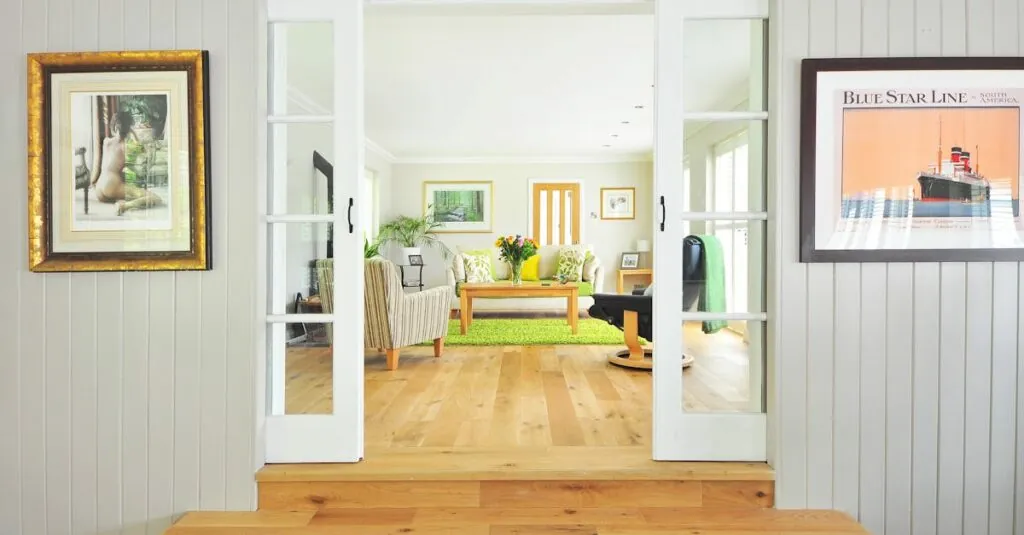Imagine waking up in a space that feels like a breath of fresh air—where every item serves a purpose and clutter is a thing of the past. Minimalist living spaces aren’t just about having fewer things; they’re about creating a sanctuary that sparks joy and promotes peace of mind. Who knew that less could actually mean more?
Table of Contents
ToggleThe Concept of Minimalist Living Spaces
Minimalist living spaces create serene environments that promote joy and tranquility. Embracing minimalism involves more than just reducing possessions; it transforms how individuals experience their surroundings.
Definition and Origins
Minimalist living focuses on simplicity and functionality. The term “minimalism” emerged in the mid-20th century, influenced by art movements advocating abstraction. It emphasizes reducing distractions to enhance awareness and appreciation of life’s moments. Many trace its roots to various cultures that prioritize simplicity, including Japanese Zen philosophy, which values uncluttered spaces fostering mindfulness.
Key Principles of Minimalism
Key principles guide minimalist living. First, prioritization entails keeping only items that serve a purpose or evoke joy. Second, functionality emphasizes choosing furniture and decor that enhance the living experience without overcrowding spaces. Third, cohesion results from selecting a harmonious color palette and consistent design elements. Lastly, intentionality encourages thoughtful organization, ensuring each item has a designated place. Together, these principles create aesthetically pleasing and calming environments.
Benefits of Minimalist Living
Embracing minimalist living spaces offers numerous advantages. Individuals often experience significant improvements in their daily lives.
Enhanced Mental Clarity
Living minimally promotes enhanced mental clarity. With fewer distractions, individuals can focus on what truly matters. Simplified surroundings encourage mindfulness and creative thinking. Research indicates that clutter-free environments reduce cognitive load, allowing for better decision-making. Prioritizing essential items fosters a sense of purpose and direction. Ultimately, these changes lead to increased productivity and improved well-being.
Reduced Stress and Overwhelm
Minimalist living directly correlates with reduced stress and overwhelm. An uncluttered space creates a calming atmosphere, helping individuals feel more relaxed. Fewer possessions translate to less maintenance and cleaning, contributing to a sense of freedom. Studies show that streamlined environments reduce anxiety levels significantly. Adopting intentional organization methods lowers emotional burden, making it easier to enjoy daily activities. Overall, minimalist living cultivates a more peaceful and manageable lifestyle.
Designing Minimalist Living Spaces
Designing minimalist living spaces focuses on creating environments that emphasize simplicity and functionality. The goal is to foster tranquility and joy through thoughtful arrangements.
Functional Furniture Choices
Choosing functional furniture becomes essential in a minimalist setting. Select pieces that serve multiple purposes, like storage ottomans or convertible sofas. Prioritize quality over quantity for longer-lasting items. Avoid larger, bulky furniture that clutters the space. Opt for clean lines and understated designs, which promote a sense of openness. Consider natural materials, as they enhance the feel of a serene environment. Create balance by incorporating a mix of textures, but keep them subtle to maintain cohesion.
Color Palettes and Textures
Opting for a cohesive color palette ensures visual harmony. Stick to neutral tones like whites, greys, and beiges for walls and larger furniture. Accents can come from muted colors to add a touch of warmth without overwhelming the space. Textures play a crucial role in adding depth while keeping the aesthetic minimalist. Incorporate materials like wood, linen, and glass to introduce a tactile element. Layering simple textures creates interest without cluttering the visual landscape. Choose art and decor sparingly, focusing on pieces that evoke positive emotions and contribute to the overall calm atmosphere.
Challenges of Minimalist Living
Minimalist living offers benefits but presents challenges that individuals must navigate. Understanding these obstacles fosters a more informed approach.
Emotional Attachment to Items
Emotional connections to personal belongings complicate minimalist living. Many individuals struggle to let go of items that trigger cherished memories. Sentimental objects often clutter spaces and hinder the ability to prioritize functionality. Examples include family heirlooms and gifts from loved ones that hold significant meaning. Recognizing the emotional ties can aid in objectively assessing what truly enhances their lives. Rather than discarding these items entirely, individuals can consider designated storage solutions or display areas that honor their memories while minimizing clutter.
Misconceptions About Minimalism
Common misconceptions can hinder the adoption of minimalist lifestyles. Some individuals believe minimalism equates to deprivation, overlooking its emphasis on intentionality and purpose. It’s not about living with as little as possible but rather holding onto what adds value. Others think minimalism is purely aesthetic, associating it solely with stark, empty spaces. In reality, minimalist living can encompass personal style and comfort while maintaining simplicity. Understanding these misconceptions helps individuals redefine their approach and embrace a minimalist lifestyle that suits their unique needs.
Tips for Transitioning to Minimalism
Transitioning to minimalist living requires intentional changes in habits and mindset. Embracing this lifestyle facilitates a serene environment that nurtures joy and tranquility.
Decluttering Strategies
Prioritize items based on emotional value and functionality. Identify belongings that support daily life and discard duplicates or items that no longer serve purpose. Create designated zones for different categories, such as clothing or books, making it easier to visualize what’s necessary. Schedule regular decluttering sessions, targeting specific areas to maintain momentum. Begin with small spaces to build confidence, then tackle larger rooms as progress continues. Consider donating or recycling items rather than discarding them, ensuring they benefit others while contributing to overall decluttering goals.
Maintaining a Minimalist Mindset
Cultivating a minimalist mindset involves self-reflection on values and needs. Regularly assess possessions to determine their significance in daily life. Develop habits that prioritize experiences over material goods, fostering gratitude for what already exists. Practice mindfulness to reduce the urge for impulse purchases, focusing instead on intentional acquisitions that enhance daily living. Surrounding oneself with positive influences, such as like-minded individuals, reinforces commitment to minimalism. Embrace the journey; each step taken reinforces the philosophy and contributes to personal growth and fulfillment.
Embracing minimalist living spaces transforms not just physical environments but also mental landscapes. By prioritizing simplicity and functionality, individuals can cultivate a serene atmosphere that enhances their well-being. This intentional approach encourages a deeper connection to meaningful possessions while reducing stress and distractions.
As one navigates the journey toward minimalism, the focus shifts from accumulation to appreciation. Each choice made in designing a minimalist space contributes to a lifestyle that values clarity and mindfulness. Ultimately, creating a harmonious living environment fosters a sense of peace that resonates throughout daily life.



